
Mira variables are a class of pulsating stars characterized by very red colours, pulsation periods longer than 100 days, and amplitudes greater than one magnitude in infrared and 2.5 magnitude at visual wavelengths. They are red giants in the very late stages of stellar evolution, on the asymptotic giant branch (AGB), that will expel their outer envelopes as planetary nebulae and become white dwarfs within a few million years.
51 Pegasi, formally named Helvetios, is a Sun-like star located 50.6 light-years from Earth in the constellation of Pegasus. It was the first main-sequence star found to have an exoplanet orbiting it.
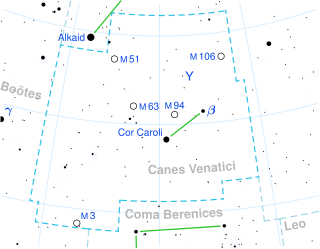
La Superba is a strikingly red giant star in the constellation Canes Venatici. It is a carbon star and semiregular variable.

R Centauri is a Mira variable star in the constellation Centaurus.

IK Pegasi is a binary star system in the constellation Pegasus. It is just luminous enough to be seen with the unaided eye, at a distance of about 154 light years from the Solar System.
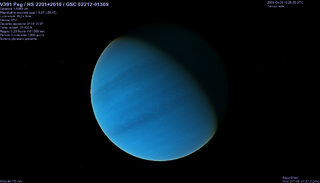
V391 Pegasi b, also known as HS 2201+2610 b, is an extrasolar planet candidate orbiting the star V391 Pegasi approximately 4,570 light-years away in the constellation of Pegasus. The candidate planet was discovered by means of variable star timing, which measured anomalies in variability of the star caused by a planet. It is the first planet candidate to claim to be detected with this method. The discovery reported the planet candidate to have mass of 3.2 times Jupiter's, semi-major axis of 1.7 AU, and orbital period of 1,170 days.

A B-type subdwarf (sdB) is a kind of subdwarf star with spectral type B. They differ from the typical subdwarf by being much hotter and brighter. They are situated at the "extreme horizontal branch" of the Hertzsprung–Russell diagram. Masses of these stars are around 0.5 solar masses, and they contain only about 1% hydrogen, with the rest being helium. Their radius is from 0.15 to 0.25 solar radii, and their temperature is from 20,000 to 40,000 K.
81 Ceti is a star located approximately 331 light years away from the Sun in the equatorial constellation of Cetus. 81 Ceti is the Flamsteed designation for this object. It is visible to the naked eye as a dim, yellow-hued point of light with an apparent visual magnitude of 5.65. The star is drifting further away from the Earth with a heliocentric radial velocity of +9 km/s.

TX Piscium is a variable red giant star in the constellation Pisces. It is amongst the reddest naked eye stars, with a significant reddish hue when seen in binoculars. It is approximately 800 light years from Earth.
HD 126614 is a trinary star system in the equatorial constellation of Virgo. The primary member, designated component A, is host to an exoplanetary companion. With an apparent visual magnitude of 8.81, it is too faint to be seen with the naked eye. The system is located at a distance of 239 light years from the Sun based on parallax measurements, but is drifting closer with a radial velocity of −33 km/s.
Kepler-70, also known as KIC 5807616 and KOI-55, is a star about 3,600 light-years away in the constellation Cygnus, with an apparent visual magnitude of 14.87. This is too faint to be seen with the naked eye; viewing it requires a telescope with an aperture of 40 cm (20 in) or more. A subdwarf B star, Kepler-70 passed through the red giant stage some 18.4 million years ago. In its present-day state, it is fusing helium in its core. Once it runs out of helium it will contract to form a white dwarf. It has a relatively small radius of about 0.2 times the Sun's radius; white dwarfs are generally much smaller. The star may be host to a planetary system with two planets, although later research indicates that this is not in fact the case.

KPD 1930+2752 is a binary star system including a subdwarf B star and a probable white dwarf with relatively high mass. Due to the nature of this astronomical system, it seems like a likely candidate for a potential type Ia supernova, a type of supernova which occurs when a white dwarf star takes on enough matter to approach the Chandrasekhar limit, the point at which electron degeneracy pressure would not be enough to support its mass. However, carbon fusion would occur before this limit was reached, releasing enough energy to overcome the force of gravity holding the star together and resulting in a supernova.

43 Sagittarii is a single star in the southern constellation of Sagittarius. It has the Bayer designation d Sagittarii, while 43 Sagittarii is the Flamsteed designation. This object is visible to the naked eye as a faint, yellow-hued star with an apparent visual magnitude of 4.88. From parallax measurements, it is estimated to lie around 470 light years away from the Sun. The star is drifting further from the Earth with a heliocentric radial velocity of +15.2 km/s. It is located near the ecliptic and thus is subject to lunar occultations.
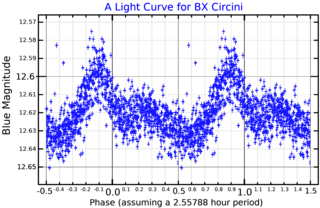
BX Circini is a star in the constellation Circinus. Its variability was discovered in 1995, with its apparent magnitude ranging from 12.57 to 12.62 over a period of 2 hours 33 minutes. It is currently classified as a PV Telescopii variable star, but has been put forward as the prototype of a new class of pulsating star—the BX Circini variables—along with the only other known example, V652 Herculis. This class of star is rare, possibly because this is a brief stage of stellar evolution. Its mass has been calculated to be around 40 percent that of the Sun, but the radius is a few times larger than that of the Sun. The average surface temperature is high, and has been measured at 23,390 ± 90 K using optical spectra, but 1750 K cooler if analysing it in both the visual and ultraviolet. The temperature appears to vary by 3450 K.

AG Pegasi is a symbiotic binary star in the constellation Pegasus. It is a close binary composed of a red giant and white dwarf, estimated to be around 2.5 and 0.6 times the mass of the Sun respectively. It is classified as a symbiotic nova; it has undergone one extremely slow nova outburst and a smaller outburst.
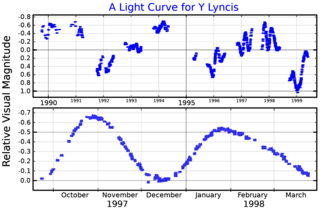
Y Lyncis is a semiregular variable star in the constellation Lynx. It is an asymptotic giant branch star of spectral type M6S, with a luminosity class of Ib, indicating a supergiant luminosity. It is around 1,160 light years away.
LS IV-14 116 is a hot subdwarf located approximately 2,000 light years away on the border between the constellations Capricornus and Aquarius. It has a surface temperature of approximately 34,000 ± 500 kelvins. Along with stars HE 2359-2844 and HE 1256-2738, LS IV-14 116 forms a new group of star called heavy metal subdwarfs. These are thought to be stars contracting to the extended horizontal branch after a helium flash and ejection of their atmospheres at the tip of the red giant branch.
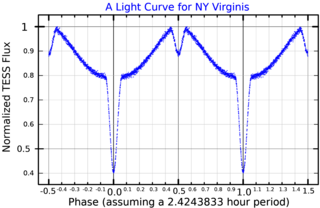
NY Virginis is a binary star about 1,940 light-years away. The primary belongs to the rare class of subdwarf B stars, being former red giants with their hydrogen envelope completely stripped by a stellar companion. The companion is a red dwarf star. The binary nature of NY Virginis was first identified in 1998, and the extremely short orbital period of 0.101016 d, together with brightness variability on the timescale of 200 seconds was noticed, resulting in the identification of the primary star as a B-type subdwarf in 2003. Under a proposed classification scheme for hot subdwarfs it would be class sdB1VII:He1. This non-standard system indicates that it is a "normal" luminosity for a hot subdwarf and that the spectrum is dominated by hydrogen rather than helium.
Kepler-429 is a variable subdwarf B star in the constellation Lyra, about 5,900 light years away.
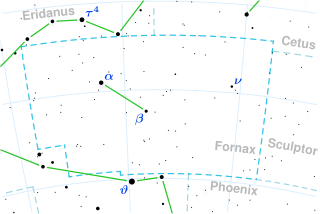
λ1 Fornacis, Latinized as Lambda1 Fornacis, is a red giant star in the southern constellation of Fornax. It is just visible to the naked eye as a dim, yellow-hued point of light with an apparent visual magnitude of 5.91. The star is located 383 light years from the Sun, based on stellar parallax, and is drifting further away with a radial velocity of +10 km/s.














